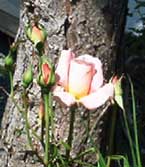container winter_care
 Is there anything
like a spring when the roses are in full bloom? They truly are the queen of
flowers, and with the increased durability and disease resistance of our antique
and garden roses, we are sure to have a variety that will delight you. Here
are some organic gardening techniques that will keep your roses healthy and
blooming:
Is there anything
like a spring when the roses are in full bloom? They truly are the queen of
flowers, and with the increased durability and disease resistance of our antique
and garden roses, we are sure to have a variety that will delight you. Here
are some organic gardening techniques that will keep your roses healthy and
blooming:
Cultural requirements:
5 to 6 hours or more of sun each day
Air circulation is very important
Good drainage is essential
Roses prefer not to compete with roots of large plants or trees
Raised beds are an excellent choice
Soil Preparation:
The object is to create a soil environment that is alive with microorganisms,
full of nutrients, with a texture that is firm enough to support roots but not
so dense that it impedes drainage.
Scrape away existing grass and weeds (Bermuda grass may require 2" to
3" depth of excavation.
Add 5" to 6" of organic compost
Consider adding worm castings (10 lbs per 1000 sq. ft.) and bat guano (10
lbs. per 1000 sq. ft.)
Rototill the compost and fertilizer into the existing soil to a depth of 3"
to 4".
Grade the beds to achieve a crown (higher in the middle). This will aid drainage.
After planting, mulch the beds. Preferably, use a 3" deep layer of shredded
hardwood. Mulch protects the roots from extremes of heat and cold, controls
weeds and improves the soil as it decomposes. Replenish the mulch two to three
times per year.
Ongoing Maintenance:
Water as necessary. During the growing season, water about every 7 to 10
days. Water deeply in order to encourage deep and sturdy root systems.
Consider a drip irrigation system to minimize over spray on foliage. Water
in the morning.
Apply 100% organic fertilizers (ex. Sustane, Green Sense, etc.) every 60 to
90 days during the growing season. Start the program approximately two weeks
before the last frost date and continue until six weeks before the earliest
frost date for the season.
Apply a foliar feeding at two week intervals. Use a mix of liquid Seaweed
(1 ounce/gallon), Fish Emulsion (2 ounce/gallon) and a biostimulant (ex. Medina,
Argrispon etc.)>
Spray a mixture of Epsom salts (1 T/gallon) and chelated iron (per label)
to occasionally darken foliage and offset iron chlorosis.
Caution: Do not spray (for disease or liquid feeding) in the heat of the day.
Wait until evening so that leaf burn will not occur.
Insects & Diseases:
Generally, if old roses are unduly affected by insects and constantly have
black spot and/or powdery mildew, check the following first:
-too much shade
-too little air circulation
-poorly drained soil
-inadequate bed preparation
-mulching is inadequate
Aphids :
-blast off with water (hose and nozzle)
-soap and water (1 tsp/gal.)
-introduce beneficial insects (ladybugs, green lacewings)
-spray garlic/pepper tea (see recipes below)
Spider mites:
-spray garlic/pepper tea (see recipes below) every 3 days for 9 days (3
applications)
-spray Seaweed (1 ounce/gal.) and Fish Emulsion (2 ounce/gal.)
Black spot/powdery mildew:
-At the first sign of black spot or powdery mildew, spray with a mix of baking
soda (4 tsp./gal.) plus soap (1 tsp/gal.) and water (1 gal.). Spray lightly
on the
foliage every 3 days until the problem is under control.
Recipes:
Garlic/Pepper Tea: Liquefy 2 bulbs of garlic and 2 hot peppers in a blender
1/3 full of water. Strain the solids out and add enough water to the garlic/pepper
juice to make a gallon of concentrate. Use 1/4 cup of concentrate per gallon
of spray.
Alfalfa Tea: 1 cup of Alfalfa Meal mixed with 5 gallons of water. Let mixture
sit overnight. Apply the mixture over the root area. Use this as a supplemental
fertilizer.
Container Roses:
Monitor the need for water frequently, especially in the hot growing months.
Roses in containers will dry out more quickly than those in the ground.
Do not over water, using a finger to probe the soil
Fertilize using worm castings and a general purpose organic fertilizer (ex.
Sustane, Green Sense) starting at the first set of flowers. Fertilize every
3 to 4 weeks.
Move roses to a sunny, protected location during winter months (root systems
will freeze).
 Is there anything
like a spring when the roses are in full bloom? They truly are the queen of
flowers, and with the increased durability and disease resistance of our antique
and garden roses, we are sure to have a variety that will delight you. Here
are some organic gardening techniques that will keep your roses healthy and
blooming:
Is there anything
like a spring when the roses are in full bloom? They truly are the queen of
flowers, and with the increased durability and disease resistance of our antique
and garden roses, we are sure to have a variety that will delight you. Here
are some organic gardening techniques that will keep your roses healthy and
blooming: